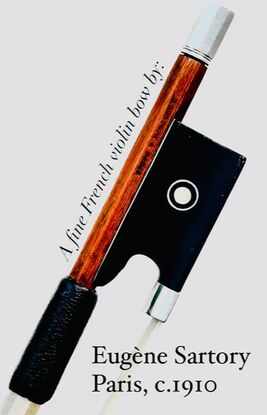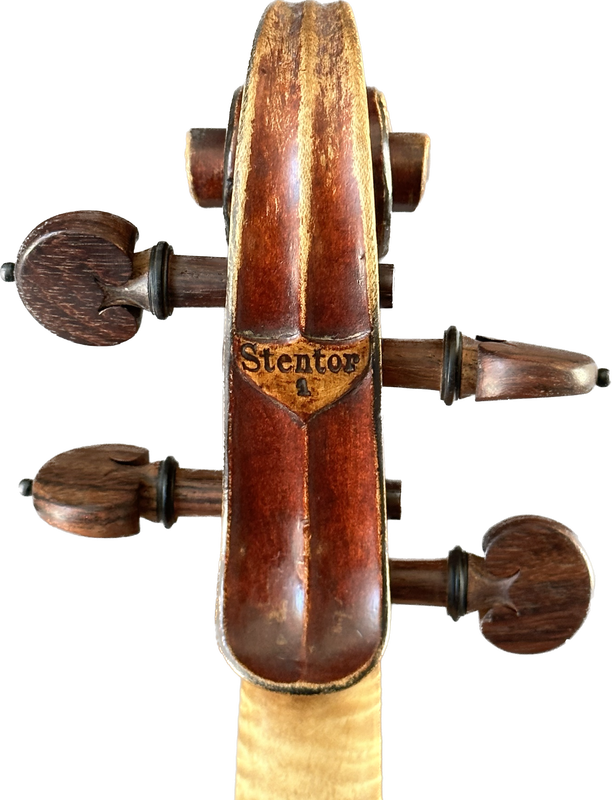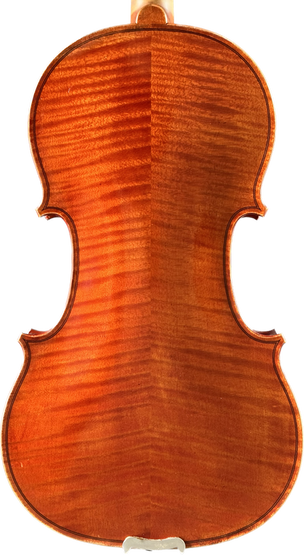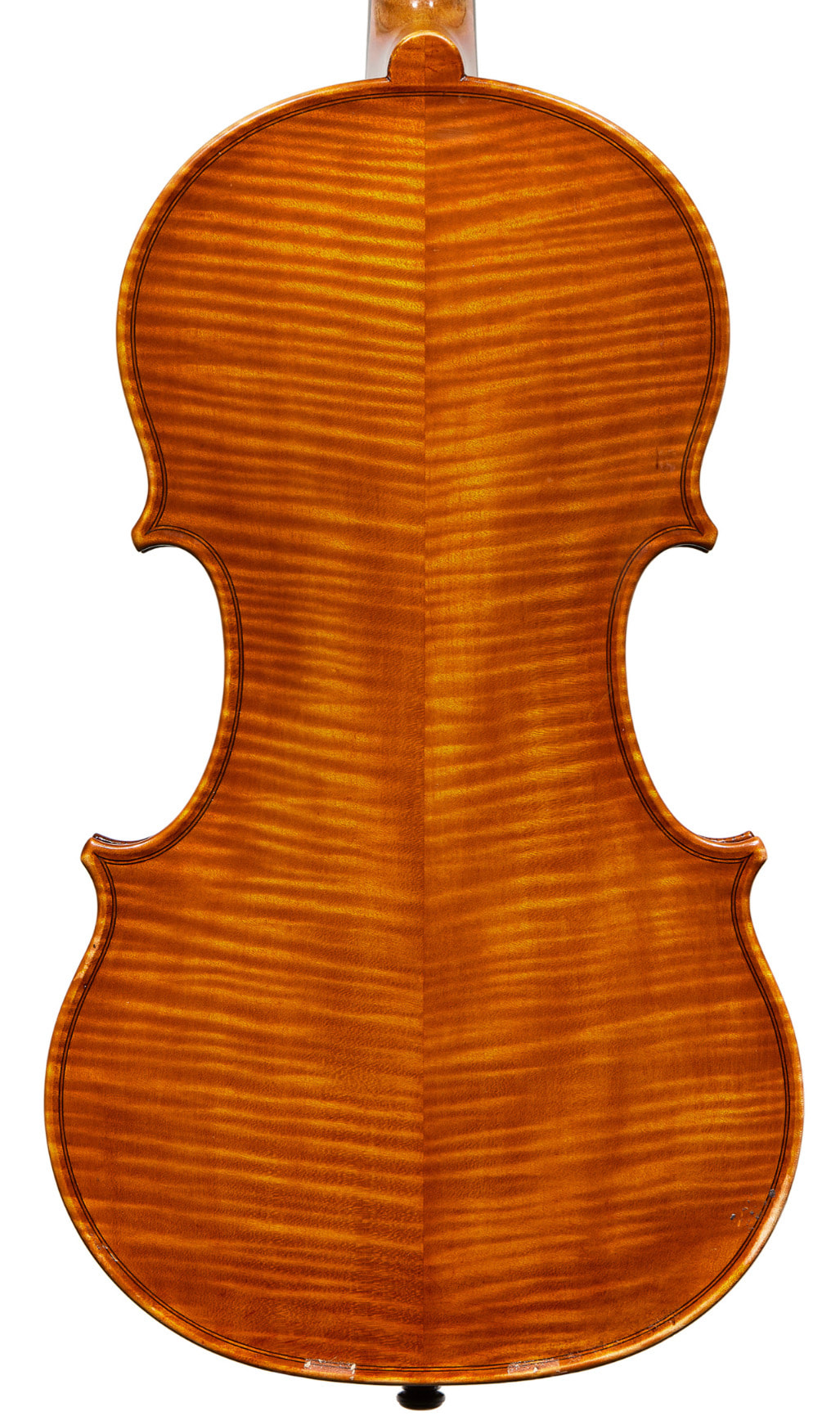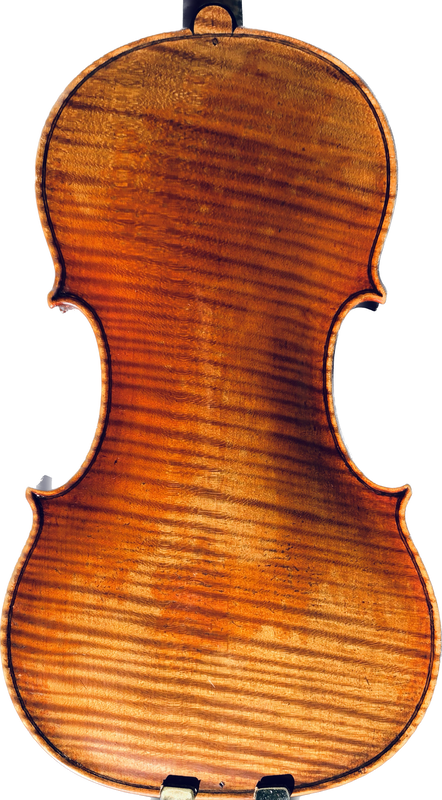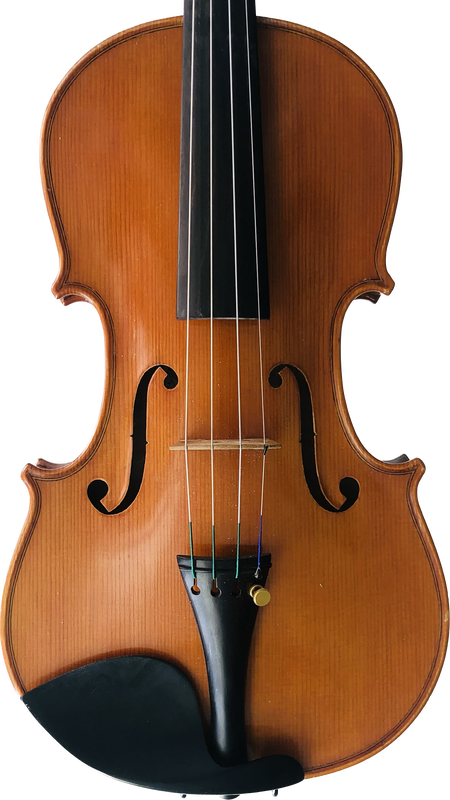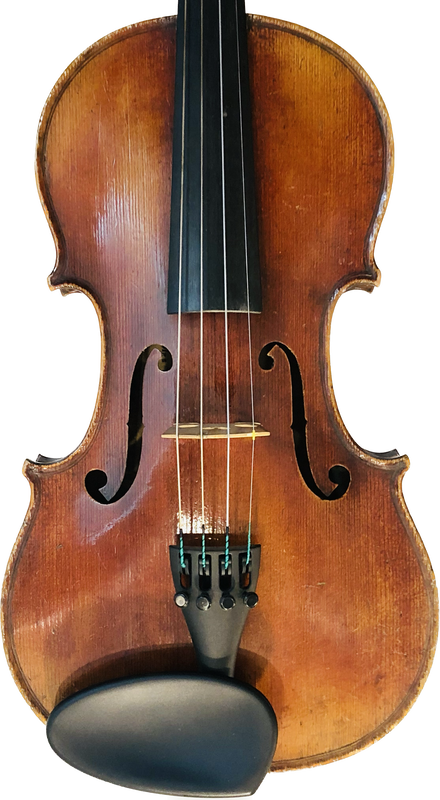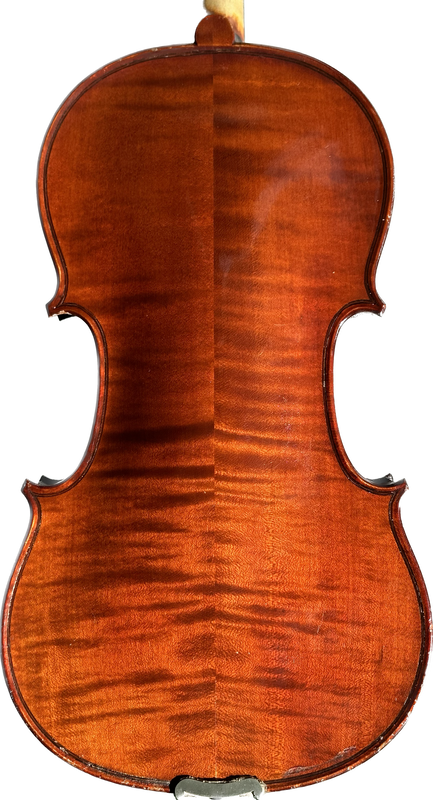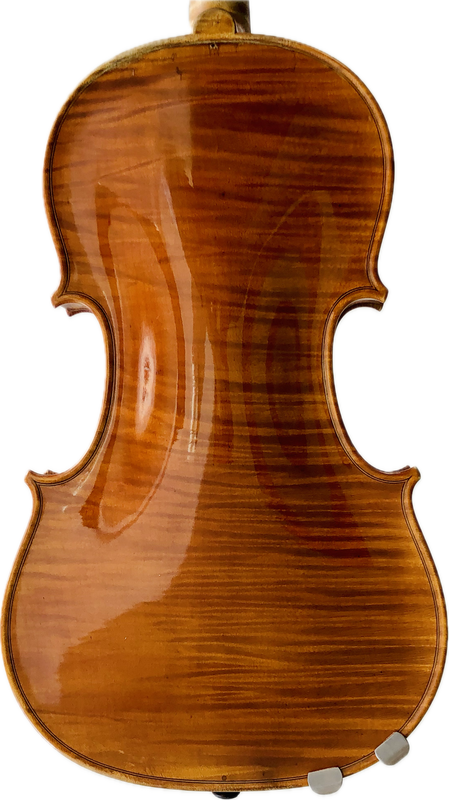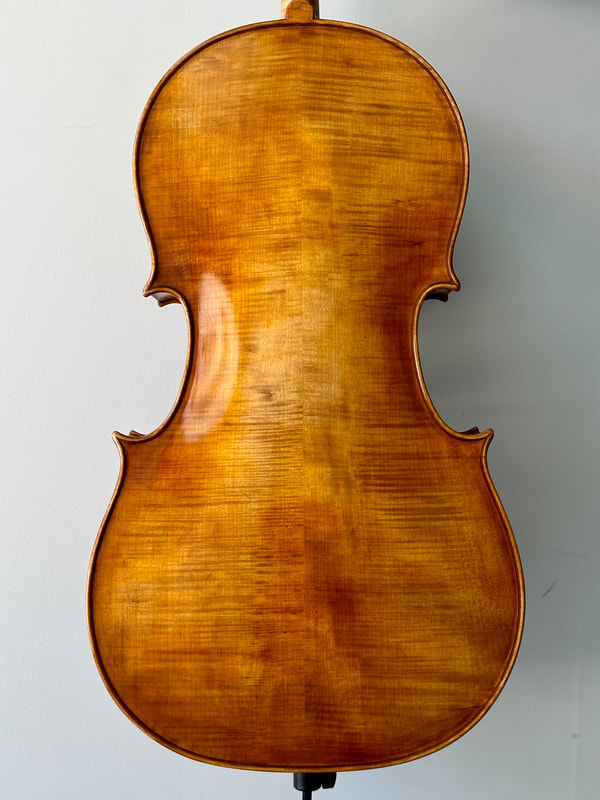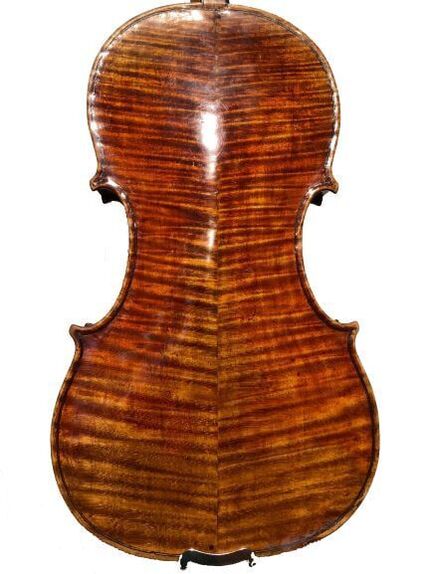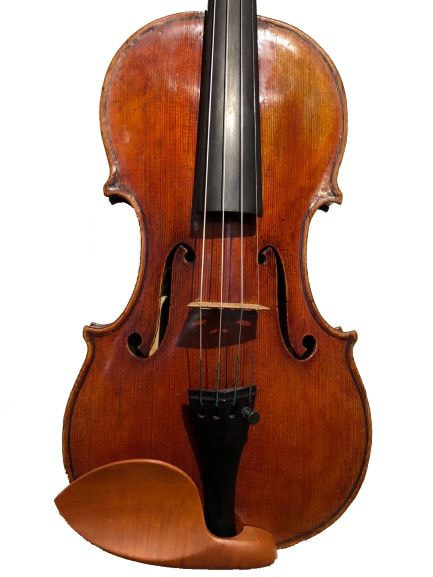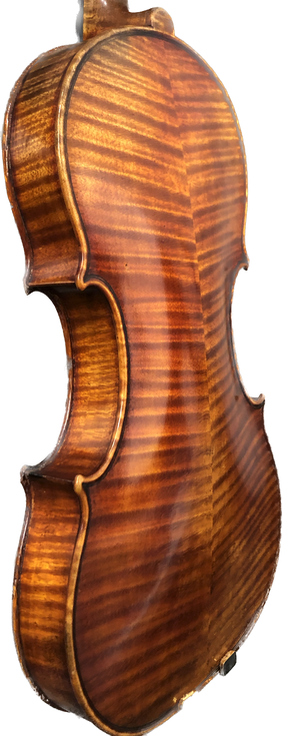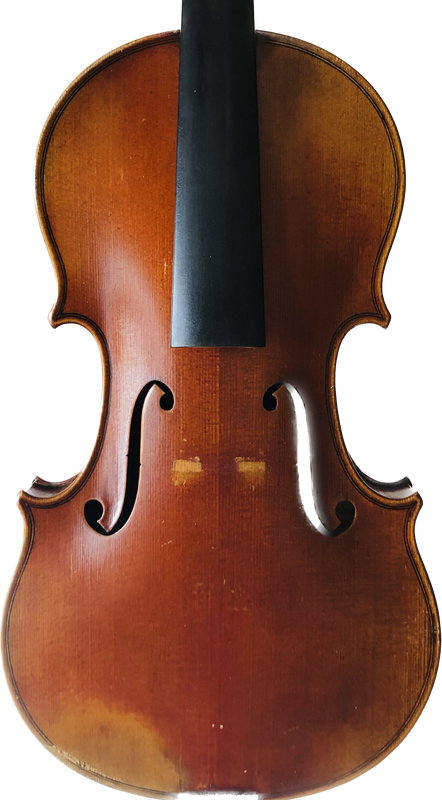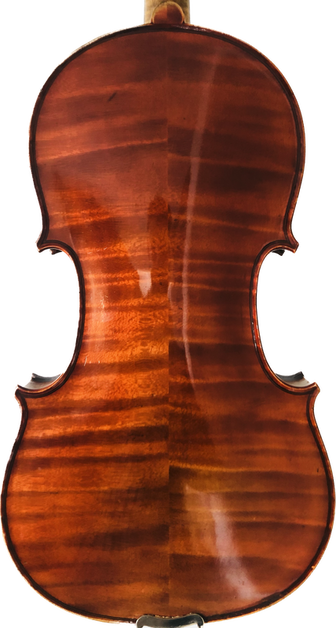Recently Sold
|
Leopold Widhalm, Nürnberg c.1775
Featured Instrument The Widhalm family produced very fine instruments influenced largely by Stainer, blending some characteristics of the Amatis at times and infusing their own creative energy. Leopold Widhalm (b.1722, d.1776) is considered the finest maker of this dynasty. This instrument displays Widhalm’s beautifully shaped f-holes, gracefully elongated corners and gorgeous varnish with a golden-honey colored ground similar to the great Italians. The tone is very mature, powerful, and bright. We sold this instrument to a member of a major symphony orchestra many years ago. The owner has since retired from the orchestra and we are pleased to offer it once more. |
|
Violin Bow by: Eugène Sartory, Paris c. 1920
Eugène Sartory (b.1871, d.1946) is generally considered the most important bowmaker of the 20th century. He set up his own shop at 18 years of age and went on to employ legendary makers such as Jules Fétique and Louis Morizot (among others) as his assistance, finishing off each bow and making sure that they met his meticulous standards of approval. His models take their inspiration largely from Voirin and Lamy but Sartory introduced elements which infused the elegant designs of his predecessors with increased strength, allowing the player to drive the bow harder. Eugène Ysaÿe was one of Sartory's biggest advocates. Sartory bows have also found their way into the hands of countless orchestra players and virtually every important collection. They continue to remain in the highest demand today. This example dates to the maker's best period and has spent the last many years paired with an 18th century Italian masterpiece of violinmaking. Sold with Paul Childs Certificate Weight: 61.2 grams |
|
Nicolas Vuillaume - 'Stentor 1', Mirecourt & Paris c. 1860
Featured Instrument We are pleased to offer this wonderful Nicolas Vuillaume “Stentor” violin c.1860. Nicolas was the brother of the famed Jean-Baptiste Vuillaume. The Stentor models were made "in the white" at the Mirecourt-based shop of Nicolas Vuillaume and sent J.B. Vuillaume Paris shop for completion. The “Stentor”model was named for a herald of the Greeks in the Trojan War and whose voice was as powerful as 50 other men according to Homer. This violin has great tonal abilities and has been serving the professional needs of one of our dear friends and clients for many years. The instrument possesses a beautiful red varnish and has a lovely and complex tone from top to bottom. Its breadth and depth combine with rich sonority, maturity and sparkling overtones to create an extraordinary violin in its class. It is also in phenomenal condition. It would be a great partner for any player looking for a versatile instrument capable of being either subtle or bold at the player’s whim. We are pleased to offer it for sale for the first time in many years. |
|
Carl Becker & Son, Chicago 1957
Featured Instrument An excellent violin by Carl Becker & Son, Chicago 1957. Carl G. Becker (b.1887, d.1975) and his son, Carl F. Becker (b.1919, d.2013) are regarded as the two finest American violinmakers. Carl Becker Sr. made his first instrument at 14 years of age and was shortly thereafter employed by Lyon & Healy then William Lewis & Sons where he remained until 1968, at which time he and his son started their own company. Carl Becker Jr. began assisting his father in his production in the mid-30’s. Their many instruments feature exquisitely precise workmanship, remarkably soft, thin oil varnish, and smooth, rich, powerful and beautiful singing tone. Additionally, they repaired and restored many masterpieces including the ‘Lady Blunt’ Stradivarius. Many of the world's leading players use these superb instruments including a large number of the Chicago Symphony Orchestra. |
|
Igino Sderci, Florence 1956
Featured Instrument Nicolo Iginio Sderci (b.1884, d.1983) was a highly prolific maker, having produced over 700 instruments over his long life. Prior to making violins, Sderci was employed as a sculptor and wood carver of ornate furniture. Recognizing his abilities, the famed Leandro Bisiach trained and hired Sderci. Enthusiastic about his work, Sderci went on to make tonally stellar instruments which many professionals built their careers on (including Nathan Cole, First Associate Concertmaster of the LA Phil). Sderci won the highest award for his work at the 1949 Cremona Exhibition. This example is in virtually mint condition and is sold with a certificate from William Moennig & Son calling this “one of Nicolo Sderci’s finest works”. For more information on this maker, please visit our featured article, "Leandro Bisiach - His Life & Art" |
|
Nicolas Darche, Aix-la-Chapelle 1843
Featured Instrument This fine violin is by a maker whose work is little known and very rare but who, nevertheless, produced some extraordinary instruments. Nicolas Darche (b. 1815, d.1873) came from a family of French violin makers. He worked for N.F. Vuillaume in Brussels before opening his shop in Aix-la-Chapelle, France (now Aachen, Germany). The renowned Joseph Hel had worked for Darche for some years before his decline. Though a difficult life prevented him from succeeding in business into his later years, he left us with some extraordinary examples of French violinmaking such as this Guarneri model which draws much inspiration from his master, N.F. Vuillaume and from the great Nicolas Lupot as we see in the exquisite materials and superb red varnish on a golden ground which reflects very differently according to lighting conditions. The workmanship is superfine, crisp and clean throughout. This instrument is modeled on a Guarnerius and is of very comfortable dimensions. An interesting detail, and tribute to Darche's meticulous craftsmanship, is the square-shaped locating pin in the back which is bisected diagonally and made of two separate woods. This violin has incredible response, power and directness. |
|
Charles W Liu, Salt Lake City, 1990
Featured Instrument This violin made personally by Charles W. Liu is modeled after Stradivari. It possesses a clear, sweet sound with excellent balance. Charles Liu began his career at the age of 16 at the Beijing Technical School of Instrument Making. He earned his degree of Luthier from the Violin Making School of America in 1997 and worked for several years restoring instruments at Peter Paul Prier & Sons Violins. In 2002, he opened his first violin shop in Salt Lake City, UT and in 2012, he opened his Los Angeles, CA location. Charles W. Liu Fine Violins has an international professional clientele. Charles Liu is also the founder of the Stradivarius International Violin Competition. This example is one of Charles' earlier instruments, made before his studies with Peter Prier (and is offered at a lower price than his later instruments). Still, the instrument is finely crafted and well-rounded, suitable to a wide variety of genres and playing styles. Its tone is open, flexible and sweet. |
|
3/4 Nicolas Vuillaume - 'Stentor 1', Mirecourt & Paris 1868
We are pleased to have sold this wonderful Nicolas Vuillaume “Stentor” violin c.1860. Nicolas was the brother of the famed Jean-Baptiste Vuillaume. The Stentor models were made "in the white" at the Mirecourt-based shop of Nicolas Vuillaume and sent J.B. Vuillaume Paris shop for completion. The “Stentor”model was named for a herald of the Greeks in the Trojan War and whose voice was as powerful as 50 other men according to Homer. The instrument possesses a beautiful red varnish and has a lovely, and powerful, developed tone far beyond virtually any other fractional sized instruments we've seen. It is also in phenomenal condition. |
|
Violin by Jehanne H. Blaise, Mirecourt c. 1910
Featured Instrument Not much is known about Jehanne H. Blaise though enough extant examples have led to a positive attribution. This violin is a nice example of French violinmaking. It features lovely materials from sources near Mirecourt and is generously covered in a rich wine-red varnish. The workmanship is bold and confident in its execution, if a bit solid. Its mature tone is complex and masculine with plenty of warmth. The hand-written label translates roughly to, "Tt the sign of the good Lorraine, Jahanne H. Blaise, violinmaker of Mirecourt" and features the Cross of Lorraine between the maker's initials H.B. This charming instrument will be an excellent match for the right violinist. |
|
Andras Nagy, Miskolc, Hungary 2009
Featured Instrument Hungarian violins have long had the reputation of being ideal “players’ instruments” being that they are often well crafted, beautiful instruments with superb tonal characteristics which, despite all, are modestly priced. This violin possesses a stunning one-piece back and excellent craftsmanship throughout. Its tone is well balanced and has a focused core with complex overtones. It was purchased new by a professional violinist with an international career and has been thoroughly played-in. It is an extremely responsive and reliable instrument that would suit advanced students, professionals and teachers alike. SOLD |
|
Jan Szlachtowski, Poland, 2022
Featured Instrument Jan Szlachtowski (b.1951, present) was born and raised in Nowy Targ, Poland. He had furthered his skills in the workshop of William H. Lee in Chicago and went back to his hometown where he continues to operate his shop today. Modern polish instruments offer substantial rewards for players as they often perform far better than many of their more expensive counterparts (new and old) from other regions. This handcrafted cello was made entirely in Szlachtowski’s workshop and finished by him personally. It has a tremendous sound and would best fit the conservatory-level to professional player. |
|
John Frederick Lott II, London c. 1850
Regarded by many as one of the greatest copyists of his trade, John Frederick Lott II (AKA Jack Lott, b.1804,d.1870) is one of the most interesting and enigmatic personalities in the history of the violin. His life was the subject of the book, Jack of All Trades by famed author, Charles Reade. The son of a violin maker, having at various times left the profession to be employed first as a gunsmith and later as an elephant trainer for a travelling circus, he returned to violin making after the sensational and tragic death of his elephant, Madem Djeck. His violins are amongst the most dubious of copies and even outright forgeries, sometimes incorporating various parts of instruments made by the Italian masters as well as lesser Italian makers. His instruments often blur the lines of authenticity making it difficult to assess them as composites, copies or forgeries. Indeed, it might be difficult to call some of his violins “British” when some of these are reworked Italian instruments. Violin virtuoso, Ida Haendel played on a particularly fine Lott violin which, for many years, was thought to be a Guarneri ‘Del Gesu’. Although difficult to categorize, Lott’s violins are tonally sublime. His ‘Del Gesu’ copies in particular, have much of the depth associated with the master. As per the label (which is thought to be original), this violin is a superb imitation of a Giuseppe (Joseph) Rocca, which in turn, is a purported copy of a Guarneri ‘Del Gesu’. As an Italian contemporary of Lott whose work was extremely popular in England in the mid-nineteenth century, it is probable that this violin was intended to deceive the prospective buyer as being the genuine work of Giuseppe Rocca. It has a convincingly deep and breathy tone and the wood selection is impeccable. The attention to detail is so neat that even the pegbox and interior corner blocks (which few people would ever see) are stamped “GR”. We can say without reservation that this is amongst the most interesting and compelling violins we have ever been privileged to offer. This violin is a slightly compact full-size instrument and would be ideal for a concert artist. |
|
Ernst Heinrich Roth, Markneukirchen, 1927 'IX-R' 'Reproduction of 1736 Guarnerius'
One of the greatest German makers of his generation, Ernst Heinrich Roth (b.1877,d.1948) was something of a genius. He was said be fluent in eight or nine languages and played violin, viola, cello, piano and trumpet. Having first learned the craft of violinmaking from his father, he traveled to Italy, France, Austria, Hungary, Russia and England to further his knowledge. He studied many of the great Cremonese masterworks including the "Duke of Cambridge" Stradivarius of 1725 which he reproduced extensively. An astute businessman, his shop produced different model instruments at various price points primarily for export. Each instrument carried a label, branded serial number and certificate. His best period was from 1920 and ended in 1933 with the rise of nazism. Though there are still some stand out examples after this period, they are very few and far between. Roth is said to have finished, varnish and played each instrument before it left his shop. His highest level instruments have a soft oil varnish similar to that of the great Cremonese instruments, the XI-R model being made entire by his own hand (often being custom-made or commissioned instruments). This IX-R model violin came has a deep, open tone not unlike a real Guarnerius and is the among the highest-level Roths. We sold this Roth to the first customer we showed it to. |
|
Ernst Heinrich Roth, Markneukirchen, 1928 'VIII-R' 'Reproduction of 1724 Stradivarius'
One of the greatest German makers of his generation, Ernst Heinrich Roth (b.1877,d.1948) was something of a genius. He was said be fluent in eight or nine languages and played violin, viola, cello, piano and trumpet. Having first learned the craft of violinmaking from his father, he traveled to Italy, France, Austria, Hungary, Russia and England to further his knowledge. He studied many of the great Cremonese masterworks including the "Duke of Cambridge" Stradivarius of 1725 which he reproduced extensively. An astute businessman, his shop produced different model instruments at various price points primarily for export. Each instrument carried a label, branded serial number and certificate. His best period was from 1920 and ended in 1933 with the rise of nazism. Though there are still some stand out examples after this period, they are very few and far between. Roth is said to have finished, varnish and played each instrument before it left his shop. His highest-level instruments have a soft oil varnish similar to that of the great Cremonese instruments, the XI-R model being made entire by his own hand (often being custom-made or commissioned instruments). This violin came to us in virtually mint condition, complete with the original pegs. It has a particularly sweet and lovely tone. |
|
Silvestre et Maucotel, Paris 1905
The firm of Hippolyte Chretien Silvestre & Ernest Maucotel lasted only from 1900 to 1913. Upon the death of Silvestre that year, Maucotel formed a partnership with Paul Deschamp. In the short span of their association Silvestre & Maucotel produced many fine instruments which we consider undervalued for their level of craftsmanship and tone. This beautiful French violin built on a 1690's Stradivarius pattern (image slightly elongated from wide lens) exhibits choice materials, crisp workmanship and is covered in lush, transparent wine-red varnish. It has a sweet and balanced tone and makes an elegant choice in almost any musical setting. |


